
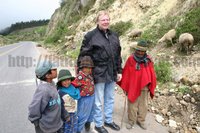 Today we drove through the mountains from Salcedo to Chunchi. Only a few minutes after we left Salcedo we saw the much talked about yet elusive cuy. Cuy is the Spanish name for "guinea pig". Those little critters that you see roasting on the spit are indeed sizzling guinea pigs. We, of course, couldn't help but dig in!! We particularly liked the little rotisserie unit they were spinning on. Okay, okay! We actually had roasted pork, not cuy, which is what you see us snacking on in the pictures. Aside from being a little apprehensive of eating them, the guinea pigs were $12-15 US each! To put that into perspective, our dinner in the evening was $2.50 which included two bowls of soup, a plate of meat, rice and beans, and two fresh papaya juices. No wonder it's a delicacy....those suckers are expensive! This particular restaurant also offered a typical drink of some sort called chicha
Today we drove through the mountains from Salcedo to Chunchi. Only a few minutes after we left Salcedo we saw the much talked about yet elusive cuy. Cuy is the Spanish name for "guinea pig". Those little critters that you see roasting on the spit are indeed sizzling guinea pigs. We, of course, couldn't help but dig in!! We particularly liked the little rotisserie unit they were spinning on. Okay, okay! We actually had roasted pork, not cuy, which is what you see us snacking on in the pictures. Aside from being a little apprehensive of eating them, the guinea pigs were $12-15 US each! To put that into perspective, our dinner in the evening was $2.50 which included two bowls of soup, a plate of meat, rice and beans, and two fresh papaya juices. No wonder it's a delicacy....those suckers are expensive! This particular restaurant also offered a typical drink of some sort called chicha ,
, 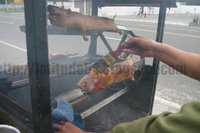 which is made from fermented maiz (corn), rice or yuca (kind of like potato). The closest thing that I can say it resembles is perhaps a cross between the taste of apple cider and mashed up corn, and the texture of pear nectar. In doing some additional research on it, I have just read that in some rural parts of Ecuador the fermentation process is augmented by human saliva. "Chicha makers (typically women) chew the ingredients and spit them back in the pot to brew". That truly concerns me a great deal, as I was just about to comment on my sampling of chicha out of an old Shell oil jug from a native out in the rural parts of Ecuador. It tasted much worse than the chicha from this morning...horrible, really, and packed a bit of a fermented punch to it, but I didn't have the heart to refuse her offer. Perhaps my kindness would have
which is made from fermented maiz (corn), rice or yuca (kind of like potato). The closest thing that I can say it resembles is perhaps a cross between the taste of apple cider and mashed up corn, and the texture of pear nectar. In doing some additional research on it, I have just read that in some rural parts of Ecuador the fermentation process is augmented by human saliva. "Chicha makers (typically women) chew the ingredients and spit them back in the pot to brew". That truly concerns me a great deal, as I was just about to comment on my sampling of chicha out of an old Shell oil jug from a native out in the rural parts of Ecuador. It tasted much worse than the chicha from this morning...horrible, really, and packed a bit of a fermented punch to it, but I didn't have the heart to refuse her offer. Perhaps my kindness would have 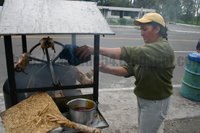 been ditched had I know that saliva was high up on the list of
been ditched had I know that saliva was high up on the list of 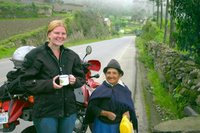 ingredients. In the mountains there is still predominately native populations. They wear the traditional clothing, which is often very ornate and colorful, but can be dark colors as well. They generally wear hats, but they seem to differ slightly in shape and colour between regions. We were very surprised at how small the natives were. Often fully grown men and women would be well below should level. We were told that perhaps their diet might have a factor in that. They plow the fields manually with bulls, and mules are used for labour as well. At this particular area we stopped to see them planting some type of grain after they dug through the soil with an old wooden plow. The plow consisted only of a metal tip that dragged through the soil. We talked with them for quite awhile, but it was difficult to understand at times because they do not actually speak Spanish, but Quecha. There are many differences between Quecha and Spanish, but a few things are universal, such as smiles and gestures, I suppose. After we said our goodbyes we continued snaking our way through the mountains. It began to get really cold up there and we were so high up that we started driving through the clouds. It was beautiful at first, but soon after we entered the clouds, they turned from mist to a blanket of fog. We were not only cold, but we were now soggy too, and our visors had fogged up as well. We had to ride with our helmets open so that we could see properly, and then the blanket of fog turned into rain. To add to the dismal scene the dogs in
ingredients. In the mountains there is still predominately native populations. They wear the traditional clothing, which is often very ornate and colorful, but can be dark colors as well. They generally wear hats, but they seem to differ slightly in shape and colour between regions. We were very surprised at how small the natives were. Often fully grown men and women would be well below should level. We were told that perhaps their diet might have a factor in that. They plow the fields manually with bulls, and mules are used for labour as well. At this particular area we stopped to see them planting some type of grain after they dug through the soil with an old wooden plow. The plow consisted only of a metal tip that dragged through the soil. We talked with them for quite awhile, but it was difficult to understand at times because they do not actually speak Spanish, but Quecha. There are many differences between Quecha and Spanish, but a few things are universal, such as smiles and gestures, I suppose. After we said our goodbyes we continued snaking our way through the mountains. It began to get really cold up there and we were so high up that we started driving through the clouds. It was beautiful at first, but soon after we entered the clouds, they turned from mist to a blanket of fog. We were not only cold, but we were now soggy too, and our visors had fogged up as well. We had to ride with our helmets open so that we could see properly, and then the blanket of fog turned into rain. To add to the dismal scene the dogs in 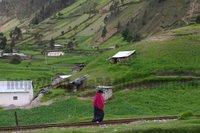
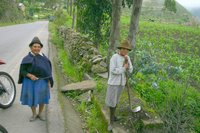 the mountains rarely see motorcycles so they absolutely honed in on us when we drove by. I counted 17 dogs that were dangerously close to becoming speedbumps, but that count only started after I clicked into the fact that a lot of dogs were chasing me. Since it was pretty slippery it was very dangerous to dodge them, so we just had to hang on to the
the mountains rarely see motorcycles so they absolutely honed in on us when we drove by. I counted 17 dogs that were dangerously close to becoming speedbumps, but that count only started after I clicked into the fact that a lot of dogs were chasing me. Since it was pretty slippery it was very dangerous to dodge them, so we just had to hang on to the 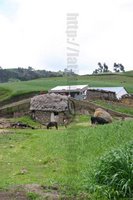 steering the best we could and hope to outrun them. I also took over my dad's bad luck with animals and had an encounter with a suicidal donkey that decided to jump out infront of my bike. Thankfully I anticipated his move and was able to dodge him in time. But, by far, the highlight would have to be that it is currently Carnival in Ecuador. Carnival is some sort of festival that they have here, that is totally beyond my comprehension but somehow involves kids throwing water at people. I can see that might be fun in the hot lowlands, but a water balloon in the neck at a 100km/h when you're desperately trying to keep warm and dry on a motorcycle is not exactly cause for celebration in my mind! We stopped in the very first town we could find. It was probably the smallest town we have stayed in so far. They actually had only one hotel..which wasn't a hotel so much as a very small hostal. It was pretty spartan, but anything was welcoming by this point in the day even though I was really hoping for a hot shower so I could warm up a little!
steering the best we could and hope to outrun them. I also took over my dad's bad luck with animals and had an encounter with a suicidal donkey that decided to jump out infront of my bike. Thankfully I anticipated his move and was able to dodge him in time. But, by far, the highlight would have to be that it is currently Carnival in Ecuador. Carnival is some sort of festival that they have here, that is totally beyond my comprehension but somehow involves kids throwing water at people. I can see that might be fun in the hot lowlands, but a water balloon in the neck at a 100km/h when you're desperately trying to keep warm and dry on a motorcycle is not exactly cause for celebration in my mind! We stopped in the very first town we could find. It was probably the smallest town we have stayed in so far. They actually had only one hotel..which wasn't a hotel so much as a very small hostal. It was pretty spartan, but anything was welcoming by this point in the day even though I was really hoping for a hot shower so I could warm up a little!
So where does the name "Latitude Fifty Four" come from?
The final destination for this motorcycle adventure was the city of Ushuaia located in Tierra Del Fuego, Argentina.
The latitude of this city is 54° 47' South.
The final destination for this motorcycle adventure was the city of Ushuaia located in Tierra Del Fuego, Argentina.
The latitude of this city is 54° 47' South.
Photographs can be enlarged by clicking on the image.
Please feel free to send comments to us by clicking on (# Comments) at the bottom of any posting.
Material made available via http://latitude54.blogspot.com/ is intended for private use only. Any re-use, transmission, duplication or distribution without express written permission is not allowed.
Please feel free to send comments to us by clicking on (# Comments) at the bottom of any posting.
Material made available via http://latitude54.blogspot.com/ is intended for private use only. Any re-use, transmission, duplication or distribution without express written permission is not allowed.
Saturday, February 18, 2006
Day 107
February 18th, 2006: Salcedo, Ecuador to Chunchi, Ecuador
Subscribe to:
Post Comments (Atom)
No comments:
Post a Comment